You are here
St. John's Lutheran Church
The Harmonists' former church was redundant even as it was built, since the Harmonists held worship services in the nearby Feast Hall. Perhaps Frederick Rapp was nostalgic for the churches of his youth in southwestern Germany, or thought that a church was a fitting complement to George Rapp's house across the street. By the early 1830s, when the Harmonist community was wracked by internal turmoil and dissent, the familiar image of a Lutheran church would have been a reassuring symbol. Architectural drawings show Frederick's thought process as he designed the church. The building's rectilinear form and tower imply a longitudinal plan, but instead, he placed a pulpit at the center of the south wall and organized the pews around it to create a communal preaching space. Entrances at the tower end (women's) and the opposite, east end (men's) kept the sexes segregated, a common characteristic of pietist groups. The church's location on Economy's main street signaled to visitors the industry and success of the society. Its four-story, square bell tower, visible for miles, was used to mark the hours of the work day and summon the fire company. Today, under Lutheran ownership, the church has the processional plan that its exterior suggests, with the pulpit at the east end lit by a stained glass window.
Writing Credits
If SAH Archipedia has been useful to you, please consider supporting it.
SAH Archipedia tells the story of the United States through its buildings, landscapes, and cities. This freely available resource empowers the public with authoritative knowledge that deepens their understanding and appreciation of the built environment. But the Society of Architectural Historians, which created SAH Archipedia with University of Virginia Press, needs your support to maintain the high-caliber research, writing, photography, cartography, editing, design, and programming that make SAH Archipedia a trusted online resource available to all who value the history of place, heritage tourism, and learning.


















